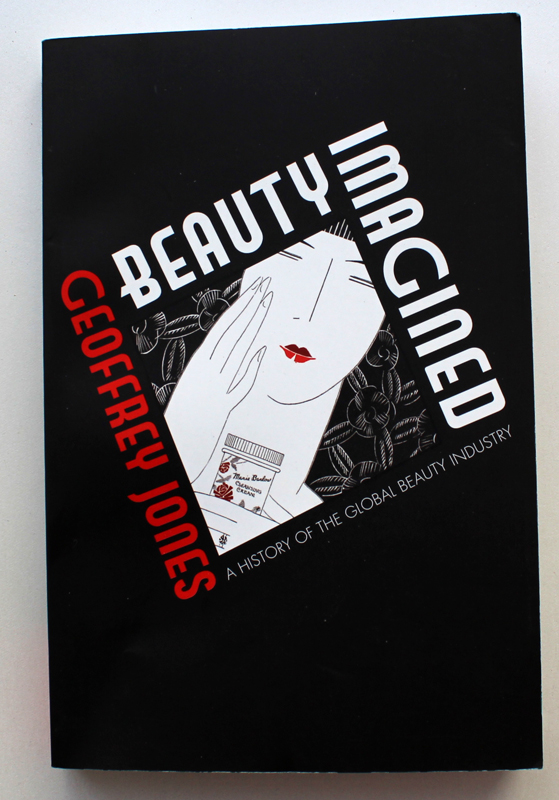 I was a little leery of this book. While it's been on my Amazon wishlist for a while, I was concerned that the author, an economist from Harvard, would take a topic I adore and turn it into something dreadfully dry and boring. Or worse, he would use all kinds of fancy jargon that someone with very little understanding of economics (i.e. me) wouldn't be able to comprehend. However, Beauty Imagined: A History of the Global Beauty Industry by Geoffrey Jones was quite enjoyable and informative. Jones thoroughly traces the industry's origins in the late 19th century through its emergence as the mammoth business it is today, connecting company histories with cultural and economic shifts that ultimately helped shape the perception not just of the industry but also our very definition of beauty. While Madeleine Marsh's Compacts and Cosmetics and Kathy Peiss's Hope in a Jar are similar in subject matter, Beauty Imagined delves more fully into the economic side of beauty's history. Still, like his fellow authors on cosmetics history, Jones ensures his writing never gets dull by peppering the text with a plethora of interesting facts and figures.
I was a little leery of this book. While it's been on my Amazon wishlist for a while, I was concerned that the author, an economist from Harvard, would take a topic I adore and turn it into something dreadfully dry and boring. Or worse, he would use all kinds of fancy jargon that someone with very little understanding of economics (i.e. me) wouldn't be able to comprehend. However, Beauty Imagined: A History of the Global Beauty Industry by Geoffrey Jones was quite enjoyable and informative. Jones thoroughly traces the industry's origins in the late 19th century through its emergence as the mammoth business it is today, connecting company histories with cultural and economic shifts that ultimately helped shape the perception not just of the industry but also our very definition of beauty. While Madeleine Marsh's Compacts and Cosmetics and Kathy Peiss's Hope in a Jar are similar in subject matter, Beauty Imagined delves more fully into the economic side of beauty's history. Still, like his fellow authors on cosmetics history, Jones ensures his writing never gets dull by peppering the text with a plethora of interesting facts and figures.
In the first three chapters, the author gives us a compelling history of fragrance, hair products, toothpaste and soap and how these products laid the foundation for color cosmetics. It was enlightening in that I hadn't really thought of these as being the ancestral relatives of makeup; I had thought of them each having their own discrete background and not integral to, say, the development of lip gloss. But as Jones explains, without these more basic items taking root in the early 20th century, other products would not have been born.
Chapters 4 and 5 discuss how neither the Great Depression nor two world wars could stop the growth of the beauty industry, as well as the establishment of the connection between Hollywood celebrities and beauty. These chapters also explore the growing use of radio, movies and TV for beauty advertising. Chapters 6 through 8 detail the rise of globalization in the industry, describing how local companies slowly but surely transformed into regional, then national, then international brands from roughly the 1970s to the present day, along with the relationship between phamaceutical companies and beauty brands.
I thought I'd highlight some of my favorite nuggets of information:
– Coty's first fragrance, La Rose Jacquesminot, got picked up by a department store after the founder smashed a bottle of it on the counter to get customers to smell it.
– Cosmetics weren't regulated by the FDA till 1938.
– Toothpaste was available as early as the 1850s, but it was packaged in jars. Colgate invented the first collapsible toothpaste tube in 1896.
– The first metal lipstick tube was invented in 1915, and the first twist-up tube in 1921.
– Avon's original name was the California Perfume Company.
– The notion of "green" beauty goes back much further than one would think. Clarins, Yves Rocher and Biotherm were all established in the 1950s, with an emphasis on using natural, plant-based ingredients.
– As of 2010, consumers spent $382 billion (!) on cosmetics, fragrance and toiletries worldwide.
The only "problem" I had with the book in that it's not actually a problem at all is that there are complete endnotes for each chapter, and perusing them I came across a ton more beauty history books I want to read!
Bottom line: Beauty Imagined is different than other beauty books but in a good way, and an excellent read even for those of us who don't have a background in business. Oh, and if your thirst for knowledge still isn't sated, check out the videos of Dr. Jones discussing the book here and here.

